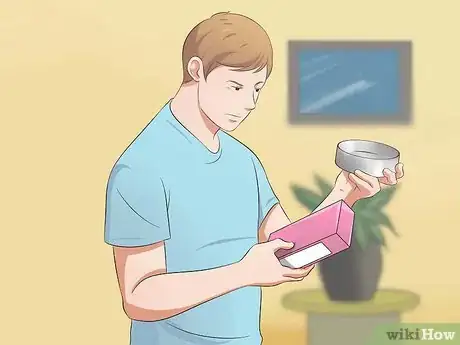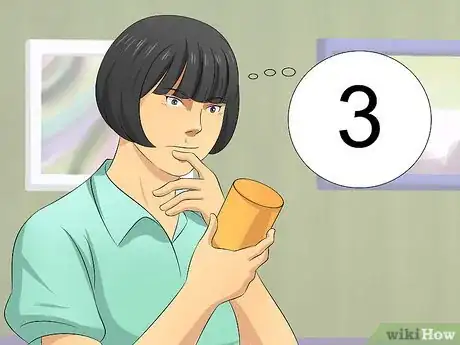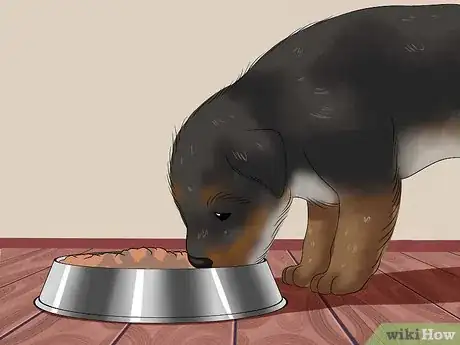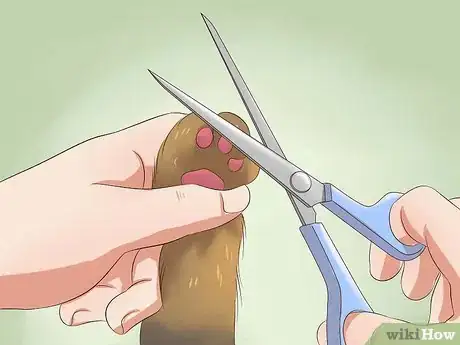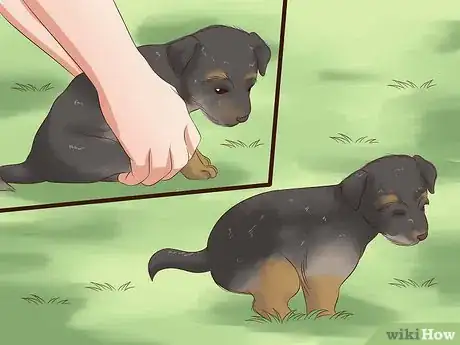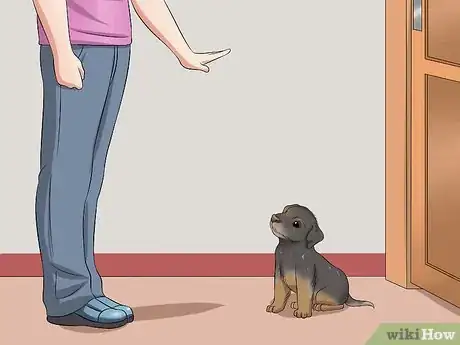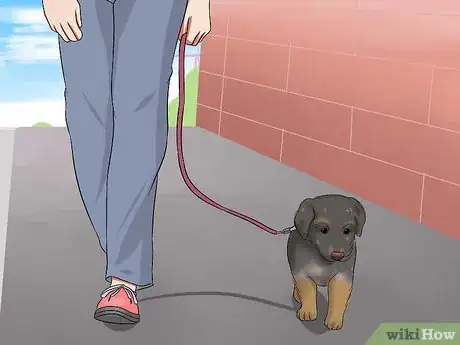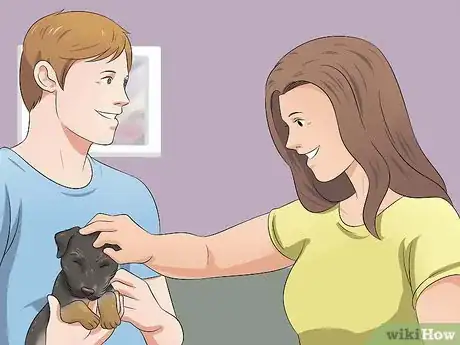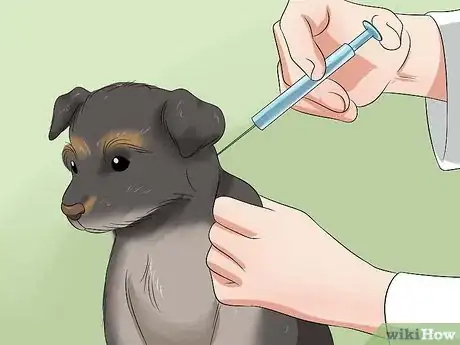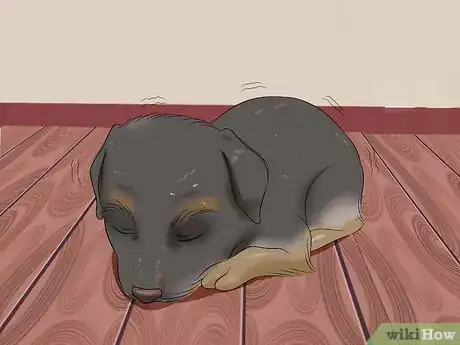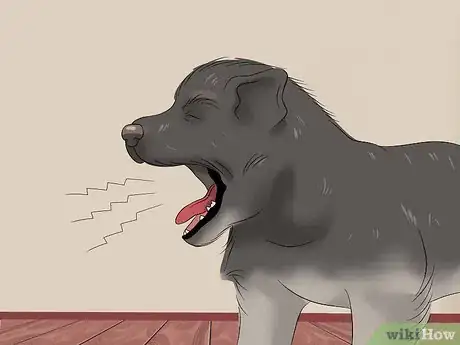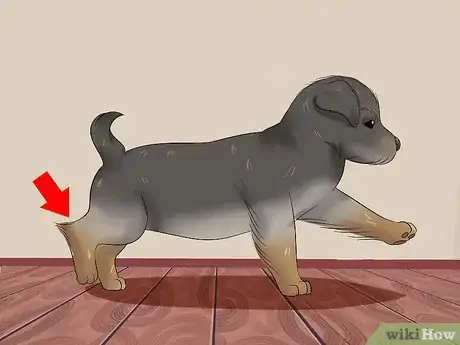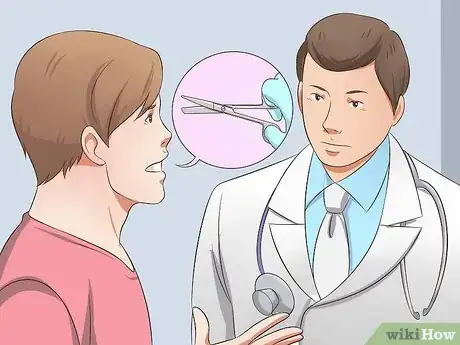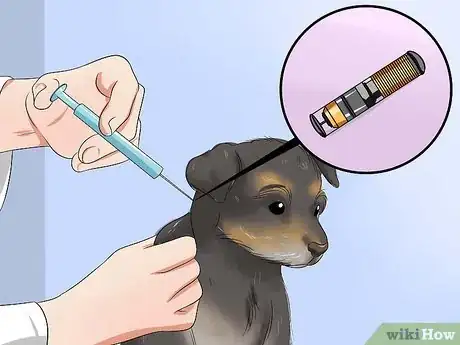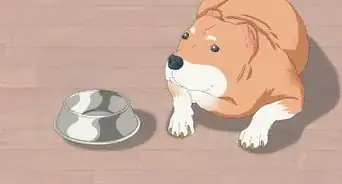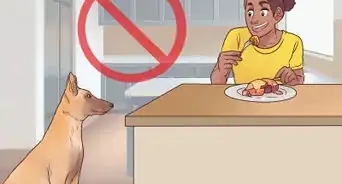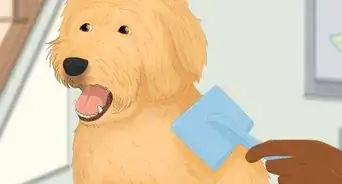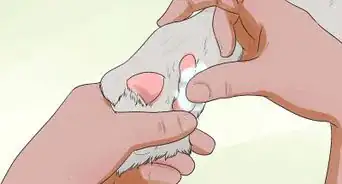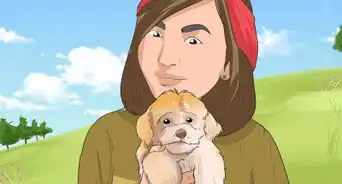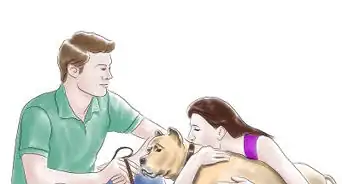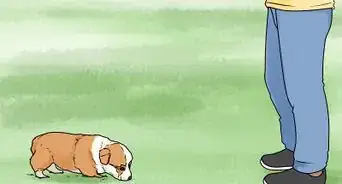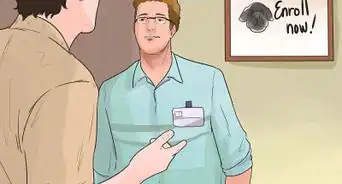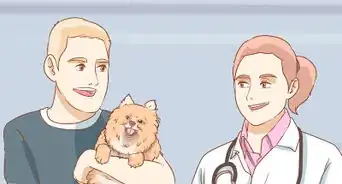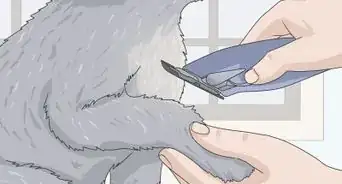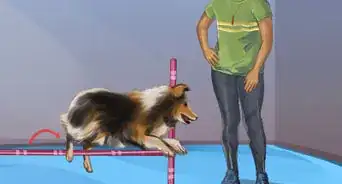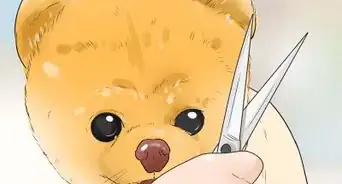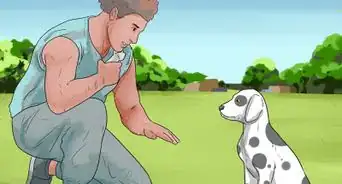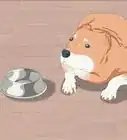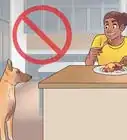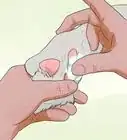This article was co-authored by Pippa Elliott, MRCVS. Dr. Elliott, BVMS, MRCVS is a veterinarian with over 30 years of experience in veterinary surgery and companion animal practice. She graduated from the University of Glasgow in 1987 with a degree in veterinary medicine and surgery. She has worked at the same animal clinic in her hometown for over 20 years.
There are 16 references cited in this article, which can be found at the bottom of the page.
wikiHow marks an article as reader-approved once it receives enough positive feedback. In this case, 100% of readers who voted found the article helpful, earning it our reader-approved status.
This article has been viewed 51,553 times.
Are you looking for an adorable tiny puppy? Chorkies are a designer breed of dog that is a cross between a Chihuahua and Yorkshire Terrier. These very small dogs have wonderful personalities, are very affectionate, and will love to curl up in your lap. They do have lots of energy though, so exercise and proper care are needed. Taking care of a Chorkie puppy isn't all that different from taking care of other breeds, but there are some special tips for raising a Chorkie.[1]
Steps
Feeding and Grooming Your Chorkie Puppy
-
1Purchase a high quality puppy food for small breed dogs. Look for a puppy food with 25-30% protein coming from meat or meat byproducts.[2] There is some debate about whether dry or canned puppy food is better. Dry food may help remove tartar from teeth. Dry and canned food are both nutritious, so choose whatever your dog prefers.[3]
- Be cautious when choosing cheaper or generic brands of dog food. They may use lower quality ingredients that might not give enough nutrition to your puppy.[4] Some good brands of puppy food are Instinct and Blue Wilderness. You can also ask your veterinarian for food recommendations.
-
2Learn how much food to give your Chorkie puppy. Refer to the specific instructions on the food package. It will probably provide you with a daily amount, so divide that number by three. This will tell you how much food you should give at each feeding.
- Avoid giving your puppy any table scraps. You should not get your dog in the habit of eating human food on a regular basis.
Advertisement -
3Establish a feeding routine. Chorkie puppies grow quickly and need to be fed more often than adult dogs.[5] Feed your puppy three times a day. Make sure that feedings are at the same time and in the same place everyday. Choose an area where your puppy won't be disturbed.[6]
- You can supplement your dog's diet with treats, but veterinarians say that these shouldn't make up any more than 10% of your dog's daily diet.
-
4Brush and bathe your Chorkie puppy regularly. You'll need puppy shampoo, conditioner, a towel, and treats. Run warm water into the tub. Give her a treat when you put her in the tub so she enjoys bath time. Slowly and gently, massage shampoo into her fur. Rinse with warm water. Then, condition and rinse. Dry her off and offer a few more treats.
- Brush the puppy daily and after baths to prevent mats and tangles. Wash your puppy once every week or two. Remain calm and speak softly while grooming your puppy. This will put her at ease.
-
5Trim your Chorkie puppy's hair. Take a pair of grooming scissors and trim the hair around your puppy's nails, eyes, and ears. Longer hair inside the ears can make Chorkies prone to ear infections, so keep the hair short.
- Make sure that hair hasn't matted down around the puppy's toes. When this happens, hair can wrap around the nails and cause them to become ingrown.[7] This can be very painful for the Chorkie.
Training and Socializing Your Chorkie Puppy
-
1Housebreak your Chorkie puppy. Start by establishing a routine. Take your puppy outside to the same general area every morning, around the same time. Once she's done her business, reward her with a small treat. This positive reinforcement will encourage her to go outside. On the other hand, never rub your your dog's face in an accident. She will not understand why you are doing this.[8]
- Luckily, training in general is very successful with Chorkies. They are smart dogs eager to learn.
-
2Teach your Chorkie simple commands. Puppies should know the basics: sit, stay, and lie down.[9] For example, teaching your dog to sit and stay by a door can be very simple. Tell your puppy to sit/stay by the door. When she does this, praise her. Open the door and let her outside. That is her reward. If she gets up as you open the door, close it and try again. Don't let her outside until she has followed the command.
- Never punish a dog for refusing a command since dogs don't understand punishment. They will respond to positive reinforcement when they do a task correctly.
-
3Get your Chorkie puppy regular exercise. Chorkies are energetic dogs, so go for long daily walks or to the dog park. [10] A puppy who gets lots of exercise and play will be calmer, and more well behaved in general.Don't forget that play counts as exercise. Chorkies love toys and games of fetch.[11] Be sure to use balls and toys designed for small breeds.
- If you do take your dog to a dog park, make sure there is a special area for small breeds.
-
4Pay attention to your dog's safety at all times. Chorkies are very small breed dogs and need special attention while playing or exercising. Always keep your puppy properly leashed and collared at all times when on a walk.[12] [13]
- For example, they can sometimes be aggressive if approached by another dog or person. So, make sure to walk your puppy along a quiet route. If your puppy pulls on the leash during walks, use a walking harness.
-
5Socialize your puppy. Give your Chorkie puppy the chance to meet lots of new people, not just people within the household. This will give her the experience of dealing with strangers and new places. Let your dog walk around and explore the new people and surroundings. If she is afraid, don't rush to pick her up or remove her. Let her adjust.[14]
- Don't take your puppy out too much before she gets all her vaccinations, usually around 15 or 16 weeks old.
-
6Prevent small dog syndrome. To avoid bad behaviors associated with small dog syndrome, train your Chorkie. Regularly walk her on a leash, let her interact with other dogs, teach commands like "sit" or "stay," and let her walk places; don't always carry her. This will teach her discipline and good behavior.[15] [16]
- Small dog syndrome is an attitude your Chorkie may develop. She may think and act like she's the boss: jumping up on people or nipping, growling, begging for food, etc.[17]
Understanding Chorkie Health and Preventative Care
-
1Get your Chorkie puppy vaccinated. Your puppy will need several vaccines before she turns a year. Generally, puppies need to be vaccinated at 5 weeks, 6, weeks, 9 weeks, 12 weeks, and 15 weeks old. Your puppy should get core vaccines that include: distemper, canine adenovirus-2 (hepatitis and respiratory disease), canine parvovirus-2 and rabies. Talk with your veterinarian about giving your puppy non-core vaccines.
- After your Chorkie has gotten all of her shots as a puppy, she'll need to see the veterinarian at least once a year.[18] She may occasionally need to get booster shots.
-
2Get your puppy dewormed. Puppies are likely to get worms several times while growing up. Ask your vet about preventative worming when your Chorkie is 2 to 3 weeks old. The veterinarian can give your puppy medication by mouth or give her a shot to kill any parasites. You'll need to follow up in a couple of weeks to get another dose of medication. This will kill any parasites that hatched.[19]
- Recognize signs of worms in your puppy. If you notice your puppy has diarrhea or is vomiting, coughing, chewing or licking under her tail, is short of breath, or losing weight take a stool sample to the vet. Get your puppy treated for worms again.
-
3Recognize hypoglycemia in Chorkies. They're liable to have hypoglycemia, or low blood sugar. Know that Chorkies are susceptible to hypoglycemia. If so, you may notice decreased appetite, low energy, anxiety and restlessness, tremors, shivering, or confusion when doing normal things..[20] [21]
- If you notice your Chorkie puppy acting strangely, take her to the vet as quickly as possible.
-
4Watch for signs of tracheal collapse. This happens when your dog's airway constricts or collapses. You may notice a dry honking cough, difficulty breathing, repeated (unsuccessful) attempts at vomiting, rapid breathing sounds, and loss of consciousness. If your Chorkie experiences any of these symptoms, take her to a vet immediately.
- Tracheal collapse usually happens because of too much exercise, heat, or excitement. If your dog is overweight, she's also at risk for this problem.
-
5Notice any injuries, especially a dislocated kneecap. Chorkie dogs are prone to dislocated knee caps (patellar subluxation). [22] This is caused by genetics or by injuries. You may notice your puppy continually limping in her hind leg, occasionally limping and lameness, or sudden lameness. Take your puppy to the vet, since only a vet can diagnose and treat this problem.
- Normally, a dog will only feel pain when the kneecap slides out of place, but not after.
-
6Consider having your puppy neutered. There are several reasons for neutering your puppy. The main reason being to prevent your puppy from reproducing. There are pros and cons to this. For example, neutering prevents testicular cancer and prostrate problems in your dog. It may also reduce testosterone-related behavior problems. But, your dog may grow taller and gain more weight if neutered at an early age.[23]
- Talk over your options with your vet when making the decision to neuter or not.
-
7Think about getting your puppy microchipped. Millions of puppies are lost every year. Microchipping your puppy may make it easier to find her if she should get lost. Your vet will use a needle to insert a tiny chip behind her shoulder blades. It's rare, but microchipping can cause tumors near the site of the injection.
- Understand that the microchip is useful only when someone scans your lost pet, such as at a shelter. You must also have current contact information submitted in order for your pet to be returned to you. If you move or change phone numbers, submit the new information.[24]
Expert Q&A
-
QuestionWhat can we do about our puppy's bad breath?
 Pippa Elliott, MRCVSDr. Elliott, BVMS, MRCVS is a veterinarian with over 30 years of experience in veterinary surgery and companion animal practice. She graduated from the University of Glasgow in 1987 with a degree in veterinary medicine and surgery. She has worked at the same animal clinic in her hometown for over 20 years.
Pippa Elliott, MRCVSDr. Elliott, BVMS, MRCVS is a veterinarian with over 30 years of experience in veterinary surgery and companion animal practice. She graduated from the University of Glasgow in 1987 with a degree in veterinary medicine and surgery. She has worked at the same animal clinic in her hometown for over 20 years.
Veterinarian It's unusual for a puppy to have bad breath, as the commonest cause is dental disease which is associated with the older dog. Depending on the puppy's age he may be teething, and this can cause gum inflammation. Check to see if his gums look red and inflamed, and if they are then gently wiping them over with a dog toothpaste containing chlorhexidine will help. Check to see he hasn't got decaying food trapped between his teeth. And finally, make sure he is properly wormed as sometimes worm infections can cause bad breath.
It's unusual for a puppy to have bad breath, as the commonest cause is dental disease which is associated with the older dog. Depending on the puppy's age he may be teething, and this can cause gum inflammation. Check to see if his gums look red and inflamed, and if they are then gently wiping them over with a dog toothpaste containing chlorhexidine will help. Check to see he hasn't got decaying food trapped between his teeth. And finally, make sure he is properly wormed as sometimes worm infections can cause bad breath.
Warnings
- Never feed your pet any of the following human foods: chocolate, coffee, caffeine, alcohol, avocados, macadamia nuts, grapes and raisins, yeast dough, raw and undercooked meat, eggs, bones, xylitol, onions, garlic, chives, milk, or salt. [25]⧼thumbs_response⧽
References
- ↑ http://designermixes.org/breed_info/189/chorkie.aspx
- ↑ https://www.aspca.org/pet-care/dog-care/feeding-your-puppy
- ↑ http://www.cesarsway.com/dog-care/dog-nutrition/Dog-Nutrition-A-to-Z
- ↑ http://www.petmd.com/dog/puppycenter/nutrition/evr_dg_the_importance_of_proper_nutrition_for_puppies?page=2
- ↑ https://www.aspca.org/pet-care/dog-care/feeding-your-puppy
- ↑ https://www.aspca.org/pet-care/dog-care/feeding-your-puppy
- ↑ http://designermixes.org/breed_info/189/chorkie.aspx
- ↑ http://www.petguide.com/breeds/dog/chorkie/
- ↑ http://www.humanesociety.org/animals/dogs/tips/teaching_basic_commands.html
- ↑ http://designermixes.org/breed_info/189/chorkie.aspx
- ↑ http://designermixes.org/breed_info/189/chorkie.aspx
- ↑ http://www.petmd.com/dog/puppycenter/nutrition/evr_dg_the_importance_of_proper_nutrition_for_puppies?page=2
- ↑ http://designermixes.org/breed_info/189/chorkie.aspx
- ↑ http://www.smalldogplace.com/small-dog-syndrome.html
- ↑ http://www.smalldogplace.com/small-dog-syndrome.html
- ↑ http://www.petsadviser.com/behaviors/small-dog-syndrome-training/
- ↑ http://www.smalldogplace.com/small-dog-syndrome.html
- ↑ http://www.peteducation.com/article.cfm?c=2+2115&aid=950
- ↑ http://pets.webmd.com/dogs/deworming-dogs-puppies?page=2
- ↑ https://www.petcarerx.com/breed-guide/a-guide-to-chorkies-a-pint-sized-breed-with-a-large-personality/362
- ↑ http://www.petmd.com/dog/conditions/endocrine/c_dg_low_blood_sugar
- ↑ http://www.petmd.com/dog/conditions/musculoskeletal/c_multi_patellar_luxation
- ↑ https://www.aspca.org/pet-care/virtual-pet-behaviorist/dog-behavior/how-will-neutering-change-my-dog
- ↑ http://pets.webmd.com/features/microchipping-your-dog-or-cat?page=3
- ↑ https://www.aspca.org/pet-care/animal-poison-control/people-foods-avoid-feeding-your-pets
About This Article
To take care of a Chorkie puppy, feed it puppy food made up of 25 to 30 percent protein, like meat or meat byproducts, so it gets enough nutrients. You should also feed your puppy 3 times a day to support its rapid growth. After your Chorkie has eaten, take it outside to the same place each day so it learns to do its business in the yard. Additionally, bathe your puppy once every 1 or 2 weeks to remove mats in its coat and keep it clean. Then, trim the hair around its eyes, feet, and ears, which will help prevent infections. For tips from our Veterinary co-author on how to teach your puppy commands, read on!
